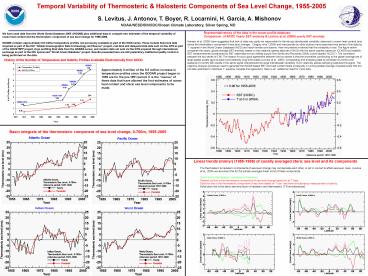Temporal Variability of Thermosteric - PowerPoint PPT Presentation
1 / 1
Title:
Temporal Variability of Thermosteric
Description:
Linear trends (mm/yr) (1955-1998) of zonally averaged steric sea level and its components ... Solid black line is the steric sea level [sum of halosteric and ... – PowerPoint PPT presentation
Number of Views:33
Avg rating:3.0/5.0
Title: Temporal Variability of Thermosteric
1
Temporal Variability of Thermosteric Halosteric
Components of Sea Level Change, 1955-2005
S. Levitus, J. Antonov, T. Boyer, R. Locarnini,
H. Garcia, A. Mishonov
NOAA/NESDIS/NODC/Ocean Climate Laboratory, Silver
Spring, MD
Representativeness of the data in the ocean
profile database Comparison of NCDC Yearly SST
anomaly Levitus et al. (2005) yearly SST anomaly
We have used data from the World Ocean Database
2005 (WOD05) plus additional data to compute new
estimates of the temporal variability of ocean
heat content and the thermosteric component of
sea level change for 1955-2005. WOD05 contains
approximately 0.9 million temperature profiles
not previously available as part of the WOD
series. These include historical data acquired as
part of the IOC Global Oceanographic Data
Archaeology and Rescue project, real-time and
delayed-mode data sent via the GTS as part of the
IOC/GTSPP project, Argo profiling float data from
the GODAE server, and modern data not sent via
the GTS acquired through international exchange
as part of the IOC sponsored World Ocean
Database project. Results presented here are
still preliminary. Additional quality control is
being performed on the data.
Hansen et al. (2005) have suggested that lack of
data may partly be responsible for the strong
interdecadal variability observed in ocean heat
content (and hence the thermosteric component of
sea level change). Gregory et al. (2004) and
manuscripts by other authors have examined time
series of the data by 1 squares in the World
Ocean Database (WOD) and reach similar
conclusions. Here we present evidence that this
variability is real. The figure below compares
the yearly, global average SST anomaly based on
the relatively sparse data set of WOD with the
same quantity based on ICOADS and satellite SST
measurements (constrained by SST observations
from drifting buoys) from Smith and Reynolds
(2004) (curve labeled NCDC). The correlation
between the two series is 0.96. The reason for
such good agreement between the two series is
that the anomalies contributing to the global
average are of large spatial scales (gyre
basin) and relatively long time scales (Levitus
et al., 2005). Compositing and analyzing data by
semester (6-month) and seasonal (3-month) still
results in the same signal characterized by large
interdecadal variability. Even relatively sparse
sampling captures this signal. The objective
analysis procedure used to generate the WODS
based SST and heat content fields is basically a
running spatial average of spatial scale 500 km,
not data restricted to individual 1 squares.
Despite this agreement, there is an additional
need for more data.
History of the Number of Temperature and Salinity
Profiles Available Electronically from NODC
Approximately 3 million of the 5.5 million
increase in temperature profiles since the GODAR
project began in 1993 are for the pre-1991
period. It is the rescue of these data that
have allowed the first estimates of ocean heat
content and steric sea level components to be
made.
Basin integrals of the thermosteric component of
sea level change, 0-700m, 1955-2005
Pacific Ocean
Atlantic Ocean
Linear trends (mm/yr) (1955-1998) of zonally
averaged steric sea level and its components
The thermosteric halosteric components of sea
level change may compensate each other, or act in
concert to affect sea level. Here, (Levitus et
al., 2005) we document this for the zonally
averaged linear trend of these components. Green
line is the halosteric component of sea level
Dashed red line is the thermosteric component of
sea level change based on all T data Solid red
line is the thermosteric component of sea level
based on T obs. that have simultaneous
measurement of salinity Solid black line is the
steric sea level sum of halosteric and
thermosteric (T-S simultaneous).
Indian Ocean
World Ocean
Indian Ocean































